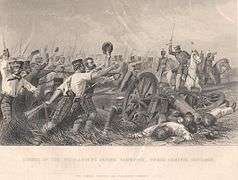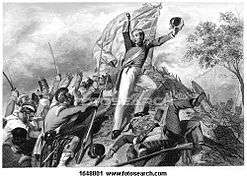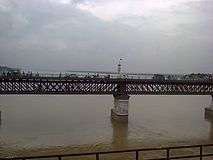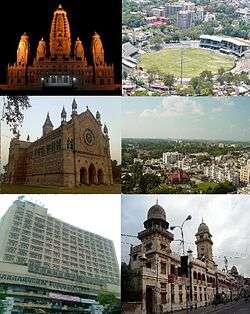Kanpur
| Kanpur कानपुर کانپور Cawnpore | |
|---|---|
|
Clockwise from top right: Green Park Stadium; Civil Lines district; Kanpur Police headquarters; Landmark Hotel; Kanpur Memorial Church; JK Temple | |
| Nickname(s): "Leather City of the world";[1] "Manchester of the East"[2] | |
 Kanpur | |
| Coordinates: 26°27′00″N 80°19′55″E / 26.449923°N 80.331874°ECoordinates: 26°27′00″N 80°19′55″E / 26.449923°N 80.331874°E | |
| Country |
|
| State | Uttar Pradesh |
| District |
Kanpur Nagar District Kanpur Dehat District |
| Government | |
| • Mayor | Shri Jagat Vir Singh Drona |
| • Deputy Mayor | Shri Haji Suhail Ahmed |
| Area | |
| • Metropolis | 403.70 km2 (155.87 sq mi) |
| Elevation | 126 m (413 ft) |
| Population [3] | |
| • Metropolis | 2,765,348 |
| • Rank | 12th |
| • Metro[4] | 2,920,496 |
| Time zone | IST (UTC+5:30) |
| PIN |
208 0xx • 209 2xx • 209 3xx • 209 4xx |
| Telephone code | 0512 |
| Vehicle registration | UP-78,77 |
| Coastline | 0 kilometres (0 mi) |
| Sex ratio | 0.855 ♂/♀ |
| Literacy | 84.37% |
| Climate | Cfa (Köppen) |
| Website |
www |
Kanpur (/ˈkɑːnpʊər/ ![]() pronunciation ; formerly Cawnpore; is the 12th most populous city in India. It is the administrative headquarters of Kanpur Nagar district and Kanpur division. It is the second largest industrial town in north India, following Delhi.
pronunciation ; formerly Cawnpore; is the 12th most populous city in India. It is the administrative headquarters of Kanpur Nagar district and Kanpur division. It is the second largest industrial town in north India, following Delhi.
The name is believed to have derived from Karnapur (meaning "town of Karna", one of the heroes of the Mahabharata). Another theory is that it came from the nearby town of Makanpur, earlier known as Khairabad, where the Sufi saint of the Madariya Sufi order, Badiuddin Zinda Shah Madar, settled.[5]
History
In 1207, Raja Kanh Deo of the Kanhpuria clan established the village of Kanhpur, which later came to be known as Kanpur.[6][7]
- Kanpur Sangrahalaya is the official museum in Kanpur
1857 uprising
In the 19th century, Kanpur was an important British garrison with barracks for 7,000 soldiers. During the Indian Rebellion of 1857, 900 British men, women and children were besieged in the fortifications for 22 days by rebels under Nana Sahib Peshwa. They surrendered on the agreement that they would get safe passage to the nearby Satti Chaura Ghat whereupon they would board barges and be allowed to go by river to Allahabad.[8]
Though controversy surrounds what exactly happened at the Satti Chaura Ghat, and who fired the first shot, it is known that, soon afterwards, the departing British were shot at by the rebel sepoys and were either killed or captured. Some of the British officers later claimed that the rebels had, on purpose, placed the boats as high in the mud as possible, to cause delay. They also claimed that Nana Sahib's camp had previously arranged for the rebels to fire upon and kill all the English. Although the East India Company later accused Nana Sahib of betrayal and murder of innocent people, no evidence has ever been found to prove that Nana Sahib had pre-planned or ordered the massacre. Some historians believe that the Satti Chaura Ghat massacre was the result of confusion, and not of any plan implemented by Nana Sahib and his associates. Lieutenant Mowbray Thomson, one of the four male survivors of the massacre, believed that the rank-and-file sepoys who spoke to him did not know of the killing to come.[9]
Many were killed and the remaining 200 British women and children were brought back to shore and sent to a building called the Bibighar (the ladies' home). After some time, the commanders of the rebels decided to kill their hostages. The rebel soldiers refused to carry out orders and butchers from the nearby town were brought in to kill the hostages three days before the British entered the city on 18 July. The dismembered bodies were thrown into a deep well nearby. The British under General Neill retook the city and committed a series of retaliations against the rebel Sepoys and those civilians caught in the area, including women, children and old men. The Kanpur Massacre, as well as similar events elsewhere, were seen by the British as justification for unrestrained vengeance.[10]
 Ruins of General Wheeler's entrenchment where Nana Sahib's forces besieged them
Ruins of General Wheeler's entrenchment where Nana Sahib's forces besieged them 1858 picture of Sati Chaura Ghat where a massacre of the British took place
1858 picture of Sati Chaura Ghat where a massacre of the British took place Highlanders led by General Havelock fight with Indian rebels to rescue the besieged British troops
Highlanders led by General Havelock fight with Indian rebels to rescue the besieged British troops British Forces capture the rebel forces in 1857 near Kanpur, India
British Forces capture the rebel forces in 1857 near Kanpur, India
Climate
| Climate data for Kanpur | |||||||||||||
|---|---|---|---|---|---|---|---|---|---|---|---|---|---|
| Month | Jan | Feb | Mar | Apr | May | Jun | Jul | Aug | Sep | Oct | Nov | Dec | Year |
| Record high °C (°F) | 31.1 (88) |
35.6 (96.1) |
42.8 (109) |
45.6 (114.1) |
47.2 (117) |
47.3 (117.1) |
45.0 (113) |
40.6 (105.1) |
40.0 (104) |
40.6 (105.1) |
36.1 (97) |
31.3 (88.3) |
47.3 (117.1) |
| Average high °C (°F) | 23.1 (73.6) |
25.9 (78.6) |
32.3 (90.1) |
38.3 (100.9) |
40.7 (105.3) |
39.0 (102.2) |
33.8 (92.8) |
32.9 (91.2) |
33.2 (91.8) |
33.0 (91.4) |
29.4 (84.9) |
24.8 (76.6) |
32.2 (90) |
| Average low °C (°F) | 7.9 (46.2) |
10.3 (50.5) |
15.3 (59.5) |
21.4 (70.5) |
25.4 (77.7) |
27.4 (81.3) |
26.3 (79.3) |
25.9 (78.6) |
24.6 (76.3) |
19.6 (67.3) |
13.0 (55.4) |
8.6 (47.5) |
18.7 (65.7) |
| Record low °C (°F) | 1.6 (34.9) |
0.6 (33.1) |
7.2 (45) |
11.1 (52) |
16.4 (61.5) |
20.6 (69.1) |
21.7 (71.1) |
21.7 (71.1) |
11.8 (53.2) |
4.6 (40.3) |
0.5 (32.9) |
−0.9 (30.4) |
−0.9 (30.4) |
| Average precipitation mm (inches) | 18.7 (0.736) |
15.7 (0.618) |
8.3 (0.327) |
7.4 (0.291) |
19.8 (0.78) |
99.0 (3.898) |
300.8 (11.843) |
233.1 (9.177) |
188.7 (7.429) |
53.8 (2.118) |
5.1 (0.201) |
9.1 (0.358) |
959.6 (37.78) |
| Average rainy days | 1.9 | 1.5 | 1.0 | 0.8 | 1.2 | 4.6 | 13.7 | 10.7 | 6.8 | 2.1 | 0.4 | 0.7 | 45.5 |
| Source: India Meteorological Department (record high and low up to 2010)[11][12] | |||||||||||||
Surrounding areas
 |
GT Amusement Park Town (GTAPT) | Gangotri Township | Shuklaganj |  |
| New Kanpur City | |
Kanpur Cantonment | ||
| ||||
| | ||||
| Rawatpur, shivrajpur , bilhaur , kannuj | Fazalganj | Govind Nagar |
Lucknow =100 km
Civic administration

| Kanpur City officials | |
| Divisional Commissioner | Mohammad Iftikharuddin[13] |
| District Magistrate | Shri Kaushal Raj Sharma[14] |
| Mayor | Captain Jagatveer Singh Dron[15] |
| Chief Metropolitan Magistrate | Peeyush Pandey[16] |
| Metropolitan Magistrate | Pradeep Kumar Jayant[17] |
Demography
As per 2011 census Kanpur city has a population of 2,701,324.The total population of the district is 4,524,324 out of which males were 24,59,806 and females were 21,21,462. The literacy rate was 70.76 per cent.[18]
The majority of Kanpur's population comprises people from Central and Western Uttar Pradesh. However, Punjabis and Anglo-Indians have also settled in large numbers in areas of Swaroop Nagar, Tilak Nagar, Azad Nagar and Civil Lines. While the majority of the population is Hindu, there is a significant Muslim minority population. There are also small groups of Sikhs, Jains, Christians and Buddhists. As per 2011 census literacy rate of Kanpur is 82.42% (http://www.census2011.co.in/census/city/131-kanpur.html).
In Kanpur, the banking services were availed by only 61 percent of the households (Census 2001). About 8 percent of the households did not possess basic assets such as vehicles (bicycles, scooter, moped, car, jeep, etc.), televisions and radios. Katiyabaaz (Powerless), a 2014 Indian documentary film deals with the issue of power theft in the city of Kanpur.[19]
There are 35 Parsis in Kanpur with their Fire Temple at The Mall.[20]
Metropolitan area
The metropolitan region defined under JNNURM by Kanpur Nagar Nigam, includes the Kanpur Nagar Nigam area, 8 kilometre around KNN boundary and newly included 47 villages of Unnao district on the north-eastern side, it extends to Murtaza Nagar, in the west its limit is up to Akbarpur, Kanpur Dehat Nagar Panchayat limit, in the eastern side the limit has been expanded on the road leading to Fatehpur and in extended up to. The metropolitan region area includes the area of Shuklaganj Municipal Committee (Nagar Palika), Unnao Municipal Committee (Nagar Palika), Akbarpur Village Authority (Nagar Panchayat) and Bithoor Village Authority (Nagar Panchayat) area.[21] In 1997-98, total metropolitan region area has increased to 89131.15 hectare out of which 4,743.9 hectare (5.31%) was non-defined (prohibited area) and rest 29,683 hectare and 54,704 hectare (61.39%) was urban and rural area respectively.
Transport
Airways

Kanpur Airport has scheduled commercial flights to Delhi. The nearest International Airport is the Chaudhary Charan Singh International Airport at Lucknow, which is around 77.1 km from Kanpur.
Roadways
The city has had chronic problems with maintaining local roads.[22] There are several important National Highways that pass through Kanpur.
| NH No | Route | Total Length |
|---|---|---|
| NH 2 | Delhi » Mathura » Agra » Kanpur » Allahabad » Varanasi » Mohania » Barhi » Palsit » Dankuni (near Kolkata) | 2542 |
| NH 25 | Lucknow » Kanpur » Jhansi | 352 |
| NH 86 | Kanpur » Hamirpur » Mahoba » Chhatarpur » Sagar » Bhopal » Indore | 674 |
| NH 91 | Ghaziabad » Aligarh » Etah » Kannauj » Kanpur | 405 |
| NH 157 (Proposed) | Kanpur » Raebareli » Sultanpur » Shahganj » Azamgarh » Gaura Barhaj » Siwan » Muzaffarpur | 581 |
The Inter State Bus Station (ISBT) of Kanpur officially named as the "Shaheed Major Salman Khan Bus Station". It is locally known as the "Jhakarkati Bus Station" enquiry number: 0512 2328381. It provides buses to important cities of India. The other bus stations are:[23]
Ring road
The National Highways Authority of India (NHAI) is all set to develop a four-lane outer ring road along the periphery of Kanpur with an aim to prevent traffic congestion in the industrial city caused by long-distance heavy vehicles. The new road, which will help the heavy vehicles to bypass the city, will be developed on a "Built, Operate and Transfer" (BOT) basis under the phase-VII of National Highways Development Programme (NHDP).[24]
Railways
Kanpur Central is the major rail head. Beside, Kanpur Anwarganj, Panki, Govindpuri, Rawatpur and Kalyanpur are major railway halt stations. Kanpur Metro is planned MRTS for the city.
 Upstream view of Ganga from Kanpur railway bridge
Upstream view of Ganga from Kanpur railway bridge Downstream view of Ganga from Kanpur railway bridge
Downstream view of Ganga from Kanpur railway bridge- Kanpur Central (Platform view)
Sister cities
See also
- Kanpur Dehat (Lok Sabha constituency)
- Ethnic communities in Kanpur
- Kanpur Nagar (Lok Sabha constituency)
- List of cities in Uttar Pradesh
- List of engineering colleges in Kanpur
- Renamed places in Kanpur
- List of twin towns and sister cities in India
- Second Battle of Cawnpore
Notes
- ↑ "Kanpur India - Kanpur Uttar Pradesh, Kanpur City, Kanpur Guide, Kanpur Location". Iloveindia.com. Retrieved 2012-12-19.
- ↑ "Nick Name of Indian Places". Facts-about-india.com. Retrieved 2012-12-19.
- ↑ "Uttar Pradesh (India): Districts, Cities, Towns and Outgrowth Wards - Population Statistics in Maps and Charts". City population.de.
- ↑ "Uttar Pradesh (India): State, Major Agglomerations & Cities - Population Statistics in Maps and Charts". City population.de.
- ↑ Suvorova, Anna Aronovna (2004). Muslim saints of South Asia: the eleventh to fifteenth centuries- Volume 14 of RoutledgeCurzon Sūfī series. Routledge. p. 171. ISBN 0-415-31764-9.
- ↑ "Kanpur History - History of Kanpur City- History of Kanpur India". Journeymart.com. Retrieved 2015-07-29.
- ↑ "Man" (PDF). Dspace.wbpublisher.gov.in. p. 479. Retrieved 2015-07-29.
- ↑ Wright, Caleb (1863) [1863]. Historic Incidents and Life in India. J. A. Brainerd. p. 239. ISBN 978-1-135-72312-5.
- ↑ Sen, Surendra Nath (1995) [1957]. Eighteen Fifty-seven. Publications Division, Ministry of Information & Broadcasting, Government of India. p. 145. ISBN 81-230-0093-6.
- ↑ Dalrymple, W. 2007. The Last Mughal. The Fall of a Dynasty: Delhi, 1857, Alfred Knopf, New York
- ↑ "Kanpur Climatological Table Period: 1971–1990". India Meteorological Department. Retrieved April 11, 2015.
- ↑ "Ever recorded Maximum and minimum temperatures up to 2010" (PDF). India Meteorological Department. Archived from the original (PDF) on 21 May 2013. Retrieved April 11, 2015.
- ↑ "Mohammad Iftikharuddin, new Kanpur commission er". The Times of India. 2014-04-24. Retrieved 2010-05-05.
- ↑ "Dr Roshan Jacob is new Kanpur DM". The Times of India. 2012-03-20. Retrieved 2012-03-20.
- ↑ "S.K. Nataraj elected Mayor of Kanpur". The Hindu. 2010-04-24. Retrieved 2010-05-05.
- ↑ "Court dismisses complaint against Mulayam". The Times of India. 2012-03-29. Retrieved 2010-05-05.
- ↑ "Metropolitan Magistrate". Kanpur District Court. 2012-04-15. Retrieved 2011-04-08.
- ↑ "Urban Agglomerations/Cities having population 1 lakh and above" (PDF). Provisional Population Totals, Census of India 2011. Retrieved 2012-07-07.
- ↑ "'Katiyabaaz': A documentary maker challenges mainstream space". The Times of India. 23 August 2014. Retrieved 2014-08-30.
- ↑ "Appeal – Cawnpore Parsee Anjuman, Kanpur | Parsis, Iranis, Zarathushtis - ALL Under One Roof". Zoroastrians.net. Retrieved 2015-07-29.
- ↑ "Final Report : Kanpur City" (PDF). Jnnurm.nic.in. Retrieved 2015-07-29.
- ↑ Potholed roads, eight to ten hours long power cut, overflowing drains and contaminated drinking water tell the tale of the Industrial town, which is fast turning into a big slum. Siddiqui, Faiz Rahman (29 April 2014). "'Outsider' Joshi takes on 'local' Jaiswal". The Times of India. Archived from the original on 21 July 2014.
- ↑ "UPSRTC". UPSRTC. Retrieved 2012-12-19.
- ↑ "Kanpur to get outer ring road to bypass traffic blues". Indianepress.com. Retrieved 2011-01-20.
References
- Singh, Harihar (1972). Kanpur: a study in urban geography. Indrasini Devi.
- Free Trade Unions, International Confederation for (1989). "7. Kanpur - The Experience in Textile Industry". Employment and structural change in Indian industries: a trade union viewpoint, Vol. 1. International Labour Organization. ISBN 92-2-106709-2.
- Singh, Surendra Nath (1990). Planning & development of an industrial town: a study of Kanpur. Mittal Publications. ISBN 81-7099-241-9.
- Silas, Sandeep (2005). "44. Manchester of the East: Kanpur". Discover India by Rail. Sterling Publishers. ISBN 81-207-2939-0.
External links
| Wikimedia Commons has media related to Kanpur. |
| Wikisource has the text of the 1911 Encyclopædia Britannica article Cawnpore. |
| Wikivoyage has a travel guide for Kanpur. |
